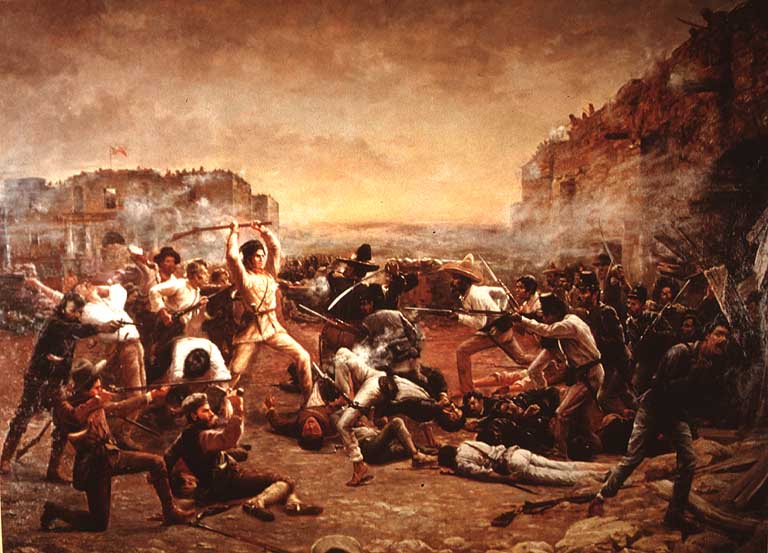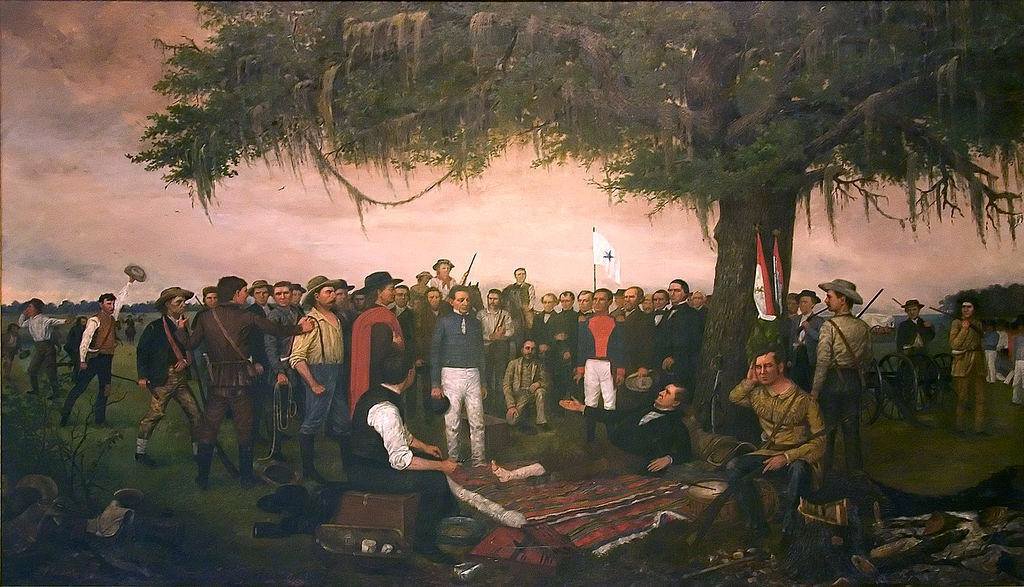
The Alamo

History Happened Here
The Alamo
Soon, the ominous news reached Texas that Santa Anna himself was marching north with 7,000 soldiers to crush the revolt. In actuality, the army of Santa Anna was not particularly impressive. It was filled with raw recruits, and included many Indian troops who spoke and understood little Spanish. When Houston learned that the initial goal of Santa Anna was to recapture San Antonio, he ordered San Antonio to be abandoned. But 150 Texas rebels, including frontier hero David Crockett, decided to defend the city and made their stand at an abandoned Spanish mission, the Alamo. The Texans were led by William Travis and Jim Bowie.

For twelve days, Mexican forces lay siege to the Alamo. Travis issued an appeal for reinforcements, but only 32 men were able to cross Mexican lines. Legend has it that on the evening of March 5, 1836, Travis, realizing that defense of the Alamo was futile, drew a line in the dirt with his sword. Only those willing to die for Texas independence, Travis announced to the garrison, should step across the line and defend the Alamo. All but two men did. One refused to cross the line, and another, Jim Bowie, too sick to move from his cot, called over some friends and had them carry him across the line.
At 5 a.m., March 6, Mexican troops scaled the walls of the mission. By 8 a.m., the fighting was over and 183 defenders lay dead—including several Mexican defenders who had fought for Texas independence. Seven defenders surrendered and were immediately executed, and approximately 15 persons survived, including an American woman and her child. Mexican forces soaked the bodies of the defenders in oil, stacked them like cordwood outside the mission, and set them ablaze.
If the Alamo was a military defeat, it was a psychological victory. The Mexican troops of Santa Anna suffered 1,550 casualties — eight Mexican soldiers died for every defender. “Remember the Alamo” became the battle cry of the Texas War of Independence.
Goliad
Two weeks after the defeat at the Alamo, a group of Texans surrendered to Mexican forces outside of Goliad with the understanding that they would be treated as prisoners of war. But Santa Anna set aside the agreement. Instead, he ordered more than 350 Texans shot.

History Happened Here
San Jacinto
The defeats gave Sam Houston time to raise and train an army. Volunteers from the American South flocked to his banner. On April 21, his army of less than 800 men surprised Santa Anna and his army as it camped out on the San Jacinto River, east of present-day Houston. The next day, the army led by Houston captured Santa Anna himself and forced him to sign a treaty granting Texas its independence—a treaty that was never ratified by the Mexican government because it was acquired under duress.
For most Mexican settlers in Texas, defeat meant that they would be relegated to second-class social, political, and economic positions. The new Texas Constitution denied citizenship and property rights to those who failed to support the revolution. All persons of Hispanic ancestry were considered in the “denial” category unless they could prove otherwise. Consequently, many Mexican landowners fled the region.

Historical Debates
The Texas Question in American Politics
Texas had barely won its independence when it decided to become a part of the United States. A referendum held soon after the Battle of San Jacinto showed Texans favoring annexation by a vote of 3,277 to 93. Despite this vote, Texas would not become part of the Union for nine years.

The annexation question became one of the most controversial issues in American politics in the late 1830s and early 1840s. The issue was not Texas but slavery. The admission of Texas to the Union would upset the sectional balance of power in the United States Senate, just as the admission of Missouri threatened fifteen years earlier. In 1838, John Quincy Adams, now a member of the House of Representatives, staged a 22-day filibuster that successfully blocked annexation. It appeared that Congress had settled the Texas question. Texas would remain an independent republic.
At this point, pro-slavery Southerners began to popularize a conspiracy theory that would eventually bring Texas into the Union as a slave state. In 1841, John Tyler, who defended slavery as a positive good, succeeded to the presidency after the death of William Henry Harrison. Tyler and his Secretary of State, John C. Calhoun, argued that Great Britain was scheming to annex Texas and to transform it into a haven for runaway slaves. In fact, British abolitionists, but not the British government, were working to convince Texas to outlaw slavery in exchange for British foreign aid. Sam Houston played along with this ploy by conducting highly visible negotiations with the British government. If the United States would not annex Texas, Houston warned, Texas would seek the support of “some other friend.”
The Texas question was the major political issue in the Presidential campaign of 1844. James Polk, the Democratic candidate, ardently supported annexation. His victory encouraged Tyler to submit a resolution to Congress calling for annexation. There were not enough votes in the Senate to ratify a treaty by the required two-thirds majority. A Congressional resolution required only a simple majority. Congress narrowly approved the resolution in 1845, making Texas the 28th state.